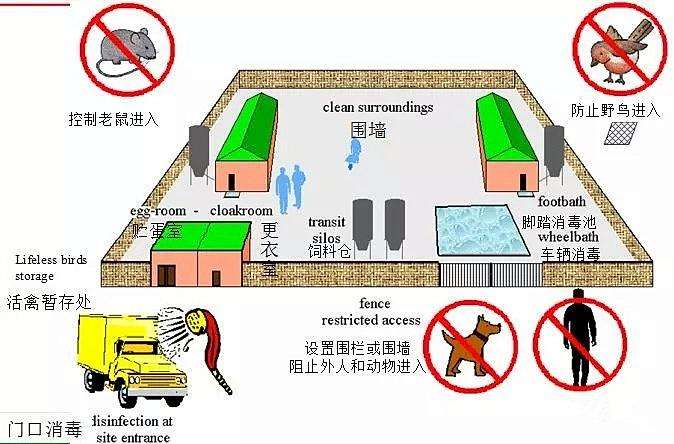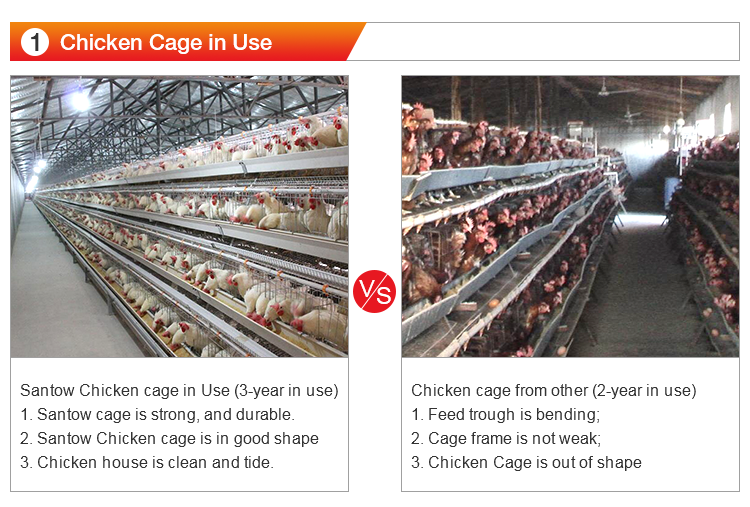

PRODUCT
CONTACT US
ZhengZhou Santow Agro Equipment Co., Ltd
Hotline:+86-371-5598 1030
Fax:+86-371-5598 1030
Phone:+86-187 6889 2838
Mail: sales@santow-agro.com
What can you do for Biosecurity on the Poultry Farm?
Biosecurity, which literally means safety of living things, is a programme designed
to prevent the exposure of birds to disease causing organisms by reducing introduction
and spread of pathogens into and between the farms.
1, Biosecurity in a broader sense encompasses isolation, traffic control sanitation,
vaccination, serological monitoring of diseases and air quality etc. which will aid to
prevent the entry and control the pathogens in and around the farm.
2, Biosecurity is the cheapest and at the same time most effective means of disease
control available without, which no disease prevention programme will work well.
3, Biosecurity is a defensive health plan and hygienic procedure that can help to keep
your farm disease free.
4, Biosecurity is therefore one of the integrated part of farm operations.
(Please scan QR Code for 720 Factory Panoramic View)

Also Read: Coccidiosis & Infectious Choryza in Chicken Farming
As the poultry operation becomes more and more efficient, however, they also become
a threat to themselves and their neighbours and the concentration of more birds in
limited space.
Poultry farmers should take time to eliminate as many disease causing organisms
as possible.
5, Therefore, it is better to wait a little longer before introducing new flock than to
hurry and risk infection of new flock, if the previous flock had been infected.
6,The most effective form of protection against disease, especially for poultry under
modern production techniques is biosecurity i.e. excluding disease from the farm
environment and this holds the key to successful and profitable farming.
7, Biosecurity, medication/ vaccination and good management of farm are three
sides of disease control triangle.
Poultry must be given an environment in which disease and infection is controlled
to the point where vaccination and medication achieve beneficial effects.
Biosecurity is the key element in the triangle of disease control.
Also Read: How to Deworm Chicken at your Chicken Farm?
*Conceptual biosecurity*
It is best to build farm in an isolated area, atleast three km away from nearest
poultry in the case of breeder farm and 1.6 km in the case of commercial layer
and broiler farm.
In the case of breeders, the farm should be away from the major road ways that
may be used to transport commercial and backyard poultry.
Maintain enough distance between breeders and grow-out farms and facilities
such as hatcheries and feed mills.

*Structural biosecurity*
Fencing of farm perimeter to prevent unwanted visitors.
Test water source for minerals, bacteria, chemical contamination and pathogen
load. This can be done at makerere university, department of food and nutrition.
Concrete stage with suitable water and power supply for sanitation of vehicles.
Tips: your fence must have a gate, where vehicles pass. There should be a tyre bath
with a good disinfectant, to wash all tyres of vehicles before entering into the farm.
Suitable location for storage of bagged feed. Its a mistake to store or leave feed
inside the poultry house. Feeds should be kept in a store, and put on pallets.
All-weather roads within the farm to ease cleaning and to prevent spreading of
microbes by vehicles and foot wear. You can put marrum to maintain the roads tidy,
though the best option would be concrete or tarmac to avoid dust.
Facilities for safe scientific disposal of dead birds. You can have an incinerator where
you burn dead birds from, or burry them far away from the farm, though an incinerator
is better.
Also Read: Debeaking? What is beak trimming and why is it carried out?
Safe housing, with suitable wild birds and rodent proofing. There should be a foot bath
at the entry of the poultry house, and this foot bath should never be dodged by workers.
Feed, litter and equipment should be stored in a section separated from live bird area to
prevent contamination.
A three metre boundary of land around the building must be kept free of all vegetation
to prevent rodent and wild life activity.
*Operational biosecurity*
Operation manuals should be developed for day-to-day activities carried out in feed mills,
hatcheries, breeding and grow-out facilities incorporating emergency plans. There should
be restriction guidelines in form of postas that show workers and visitors how safe to
handle biosecurity
Proper decontamination and disinfection of equipment, houses etc., following depletion
of flock. Don't restock any house without proper disinfection.
In breeder farms, all visitors and workers require to shower and use clean farm clothes to
prevent cross contamination between them. In commercial layer and broiler farms, all
visitors must cha he clothing at the gate, give them gumboots for the farm, register them
in the books, they must not have visited any farm two days before visiting your farm.
Maintain record for visitors and their purpose.
No vehicles or equipment should be allowed within the farm area from the time of
delivery of flock until disposal. If this can't be avoided, every equipment that enters the
farm should be disinfected.
In commercial broiler unit, a minimum inter flock interval of two weeks is recommended.
This allows a farmer to properly disinfect the premises before new flock arrives.
Use an effective integrated pest management program to control pest and rodent through
biological, chemical and mechanical means. Make use of rat traps in corners, ranirat to kill
rats, and install rat guards all around the poultry house.
Also Read: How to make more profit from Your Poultry Farming?
Appropriate program of disease diagnosis and proper vaccination schedule should be
implemented. We normally do a monthly vaccination against Newcastle and infectious
bronchitis, and monthly deworming of the birds. Since these activities cause a lot stress
to the birds, we give sangrovit WS for five days after deworming and after vaccination.
In small scale egg production unit, follow all-in-all-out system. If it is not possible, pullets
should be obtained from a source free of vertically transmitted diseases and flocks should
always be put in different houses.
It's a mistake to put birds of different age groups in one house.
Egg trays used to take eggs to the market should not be used to collect eggs from the
poultry houses. Using plastic trays to collect eggs is better, because they can be easily
disinfected.
Routine disease monitoring procedures like postmortem examination, veterinary visits
and periodic serum antibody assay to determine immune status of the flock.
Regular culling of unhealthy, unproductive and diseased birds.
All Workers should have overalls, and Boots should be put on, before a worker enters
the poultry house. Its a mistake to use the same boots walking around the farm, toilet,
feed mill/store, etc.
Mind about where your workers go when give off days. They should not visit other farms,
they should never get in contact with local birds in the village, do not allow them to own
local birds or ornamental birds, they should be properly sprayed(from the gate) before they
come back into the poultry houses.
no worker should enter a poultry unit where they don't work. Assign every worker on his
own poultry unit and they should not cross over. Limit movements in and out of the farm
Also Read: Chicken Care:Biosecurity and Health Management
write all bio security rules on their appointment letters and they should sign. Design these
rules and put them in different locations in the farm. Should any worker "bend" or break
the rules, fire and hire.
Chicken farmers should use a strong disinfectant of trusted quality with reliable origin, and
disinfecant should be very effective on all pathogens and safe for both animals, birds and
humans.
Chicken farmers have to give Amino Acids to your birds to improve their immunity, reduce
their sensitivity to infections, improve egg production, improve growth, improve appetite,
fight against stress and reduce mortality in our flocks.
